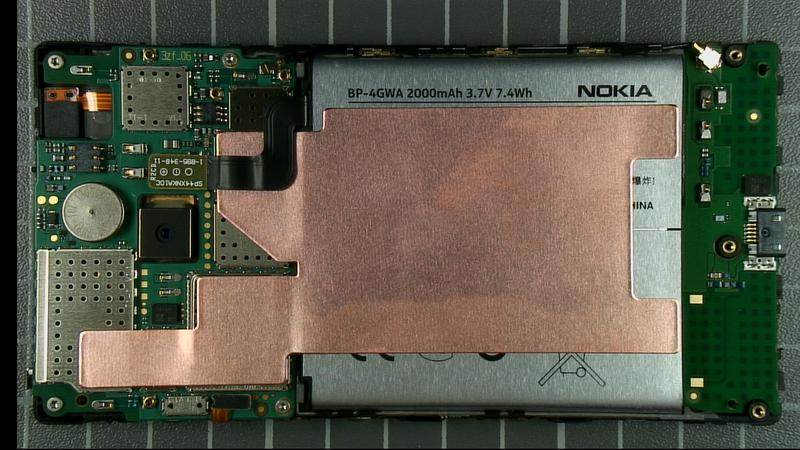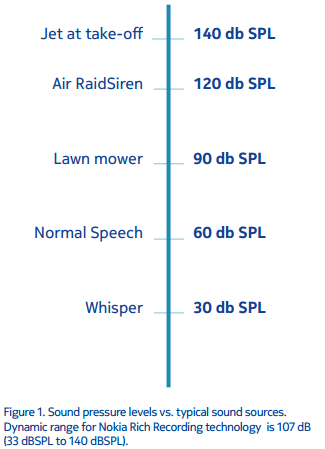Nokia's RRT (Rich Recording Technology) Audio Recording Technology
We continue to introduce you to the innovations used in the Lumia smartphones. Today we will talk about technology that allows you to record the most important moments on video with perfect sound quality.


')
To begin with, let's look at how the sounds are perceived by the human ear and microphone. The maximum sound pressure level that we can transfer is 140 dB. Such a size, comparable to the sound of a jet plane taking off at a distance of 25 meters, may well reach the noise at a rock concert, sporting event or a noisy party. This is a critical value, and the effect of the sound of such a volume can damage the organs of hearing.

Comparison of typical sources of sound pressure and their level: from a whisper to the sound of a jet plane taking off.
Visitors to such noisy events face the inability to record a video with sound without distortion. Microphones installed in conventional phones operate in a dynamic range of up to 87 dB. As a result, when recording video, the audio track is replete with noise if the noise in the process of shooting was too loud. Usually, to fix the situation, filtering of the recorded sound is used, but this cuts off the low frequencies.
Software package
In order for you to enjoy the pure sound of a video shot on Nokia Lumia, we have developed a special technology Rich Recording Technology (RRT). It consists of both software and hardware solutions aimed at an ideal result. The dynamic range of sound recording for Nokia Rich Recording technology is 107 dB (from 33 to 140 dB SPL)

Nokia Lumia video recording scheme.
The sound is captured by the microphone, then the data is processed and encoded by the audio stream compression plugin. The video is recorded by the camera module, processed and recoded. High quality audio recording is provided by AAC stereo coder with a sampling rate of 48 kHz and a bitrate of 192 kbps. HQ video is recorded using an AVC encoder (MPEG-4 Part10 AVC) with a frequency of 30 frames per second at a resolution of 1980x1080 p and a bit rate of 20 Mbps. Audio and video streams are combined into a single container file (.mp4) and saved to a finished file.
In addition, we have developed a package of sound recording algorithms for quality improvement, which includes the suppression of wind noise, camera autofocus sound, microphone equalizer and automatic adjustment of the sound amplification. The package also contains an algorithm for the HAAC microphone and provides an interface and tools for easily adjusting its sensitivity.
Thanks to these developments, Nokia Rich Recording technology ensures that loud sounds will be preserved without distinguishable noises, while quiet sounds will remain distinct.
Hardware component
A key hardware component of this technology is the HAAC microphone (High Amplitude Audio Capture), which is installed in most models of the Lumia line. It has two different levels of sensitivity and, accordingly, two channels for recording sound. After capture, the tracks are combined, and the final record has a wide dynamic range. Due to the high sensitivity, the HAAC microphone perfectly captures both very loud and very quiet sounds, and the audio track is played without distortion at any volume.
Graphically, it looks like this:

Basic microphone functionality HAAC.
Device placement
A big influence on the sound quality has the placement of microphones in the device. We try to position stereo microphones as far as possible from each other and from sources of mechanical noise and vibration in order to avoid unnecessary distortion.
Technology comparison
Thanks to the extended range of used HAAC microphones, it has become possible to record sound with volume up to 140 dB without distortion. This means that Nokia Rich Recording technology allows you to record four times louder sound than traditional digital microphones.
As a result of the need to adjust the frequency response to reduce the noise level, the RRT can provide high quality sound recordings throughout the audible range.
For information: HAAC white paper (.pdf, eng., ~ 146 kB)
Most microphones have a certain dynamic range - some are sensitive to soft sounds, while others can be perceived very loud.
It is quite difficult to create a microphone that is equally sensitive to sounds of different volume levels, while being relatively compact: the size of the components of a mobile phone is usually limited to 3-4 millimeters.


')
To begin with, let's look at how the sounds are perceived by the human ear and microphone. The maximum sound pressure level that we can transfer is 140 dB. Such a size, comparable to the sound of a jet plane taking off at a distance of 25 meters, may well reach the noise at a rock concert, sporting event or a noisy party. This is a critical value, and the effect of the sound of such a volume can damage the organs of hearing.

Comparison of typical sources of sound pressure and their level: from a whisper to the sound of a jet plane taking off.
Visitors to such noisy events face the inability to record a video with sound without distortion. Microphones installed in conventional phones operate in a dynamic range of up to 87 dB. As a result, when recording video, the audio track is replete with noise if the noise in the process of shooting was too loud. Usually, to fix the situation, filtering of the recorded sound is used, but this cuts off the low frequencies.
Software package
In order for you to enjoy the pure sound of a video shot on Nokia Lumia, we have developed a special technology Rich Recording Technology (RRT). It consists of both software and hardware solutions aimed at an ideal result. The dynamic range of sound recording for Nokia Rich Recording technology is 107 dB (from 33 to 140 dB SPL)

Nokia Lumia video recording scheme.
The sound is captured by the microphone, then the data is processed and encoded by the audio stream compression plugin. The video is recorded by the camera module, processed and recoded. High quality audio recording is provided by AAC stereo coder with a sampling rate of 48 kHz and a bitrate of 192 kbps. HQ video is recorded using an AVC encoder (MPEG-4 Part10 AVC) with a frequency of 30 frames per second at a resolution of 1980x1080 p and a bit rate of 20 Mbps. Audio and video streams are combined into a single container file (.mp4) and saved to a finished file.
In addition, we have developed a package of sound recording algorithms for quality improvement, which includes the suppression of wind noise, camera autofocus sound, microphone equalizer and automatic adjustment of the sound amplification. The package also contains an algorithm for the HAAC microphone and provides an interface and tools for easily adjusting its sensitivity.
Thanks to these developments, Nokia Rich Recording technology ensures that loud sounds will be preserved without distinguishable noises, while quiet sounds will remain distinct.
Hardware component
A key hardware component of this technology is the HAAC microphone (High Amplitude Audio Capture), which is installed in most models of the Lumia line. It has two different levels of sensitivity and, accordingly, two channels for recording sound. After capture, the tracks are combined, and the final record has a wide dynamic range. Due to the high sensitivity, the HAAC microphone perfectly captures both very loud and very quiet sounds, and the audio track is played without distortion at any volume.
Graphically, it looks like this:

Basic microphone functionality HAAC.
Device placement
A big influence on the sound quality has the placement of microphones in the device. We try to position stereo microphones as far as possible from each other and from sources of mechanical noise and vibration in order to avoid unnecessary distortion.
Technology comparison
Thanks to the extended range of used HAAC microphones, it has become possible to record sound with volume up to 140 dB without distortion. This means that Nokia Rich Recording technology allows you to record four times louder sound than traditional digital microphones.
As a result of the need to adjust the frequency response to reduce the noise level, the RRT can provide high quality sound recordings throughout the audible range.
For information: HAAC white paper (.pdf, eng., ~ 146 kB)
Source: https://habr.com/ru/post/178343/
All Articles